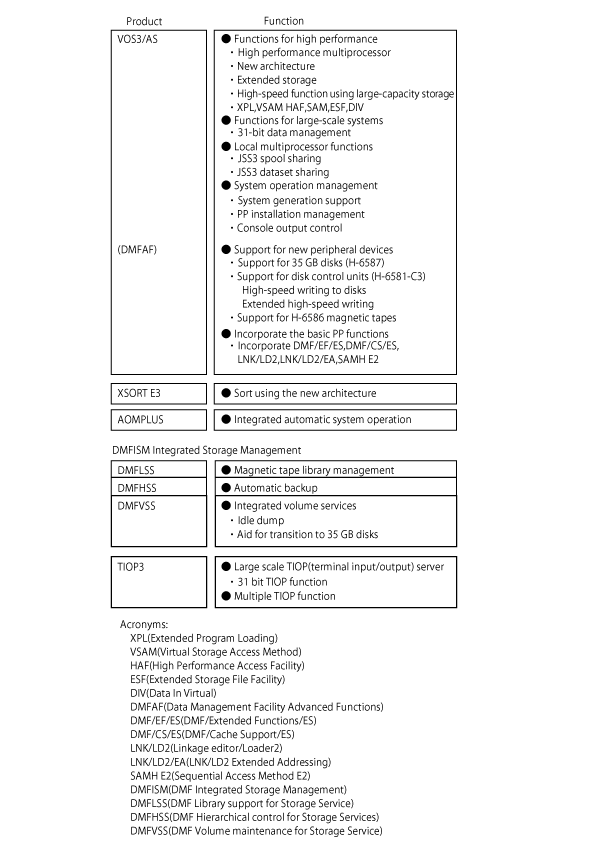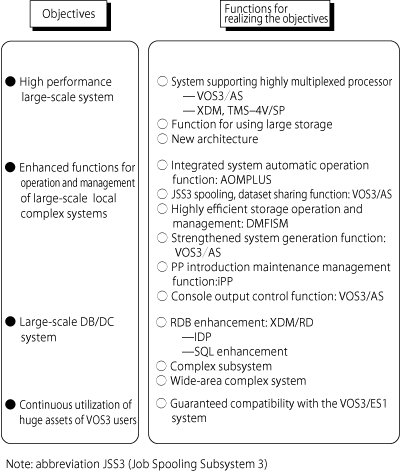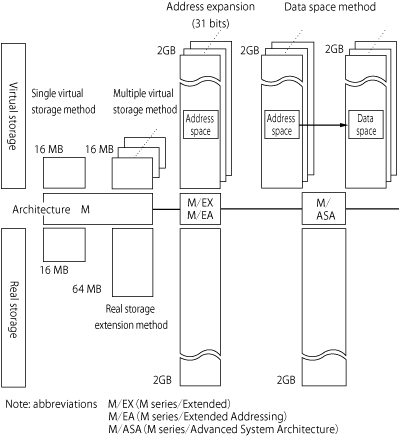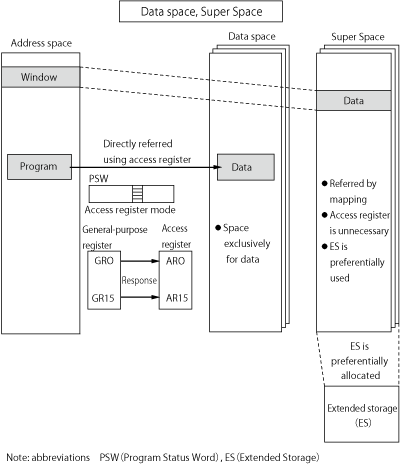With the arrival of the advanced information society, large-scale computers were required to play the role of "total management servers," which would act as the core of "wide-area complex systems." Although the size of the virtual storage was increased from 16 megabytes with VOS3 to 2 gigabytes with VOS3/ES1, even 2 gigabytes eventually became insufficient for the drastically increased sizes of systems, user data and networks. M/ASA was a new architecture that was capable of simultaneously handling large amounts of data beyond the limit of 2-gigabyte addressing, and VOS3/AS was the OS that supported it. Hitachi announced VOS3/AS in May 1990 and started shipping it in September 1990.
The VOS3/AS system consisted of the operating system VOS3/AS, a group of products surrounding the OS and a group of products including the data management system XDM and general-purpose DB/DC system TMS-4V.

- Home >
- Historical Computers in Japan >
- Mainframe OS >
- VOS3/AS
【Hitachi】 VOS3/AS

In addition to supporting new functions such as new architecture support and a function for increasing performance of the multiprocessor, the OS was equipped with an extended catalog function, a high-speed access function including logical VTOC, and a 31-bit linkage editor function as additions to its basic functions. In addition, the data processing components within the OS were organized into DMFAF (Data Management Facility Advanced Functions) and positioned as components of the integrated storage management function.
To realize efficient management and operation of the external storage, the products related to storage management were organized into DMFISM.
Figure 1 shows the objectives for the VOS3/AS system and the functions for achieving these objectives.

VOS3/AS had the following functions:
| Item | Description |
|---|---|
| Increased performance through use of large-capacity storage |
|
| Local multiprocessor system |
|
| Strengthened performance of multiprocessor system |
|
| Function for operating/managing a large-scale system |
|
In the M/ASA architecture, the storage hierarchy consisted of a high-speed, small-capacity main storage, an extended storage (ES) with a slower speed and a larger capacity, and a semiconductor-based storage with an even slower speed and a larger capacity. In the architecture, VOS3/AS had "Super Space," which was a data space for large-capacity development, in addition to the address space, allowing 16-terabyte addressing, approximately 8,000 times larger than the previous address space of 2 gigabytes in the data space. Super Space was a space reserved exclusively for data with 2 gigabytes per datum, and allowed continuous creation of a program with up to 16 terabytes. The user read and wrote data using the respective functions provided by the OS.
Figure 3 shows the transition of the addressing functions in the M series, from a single virtual storage method with VOS2 to a multiple virtual storage method with VOS3, expansion to 2 gigabytes with the M/EA architecture and expansion to 16 terabytes through a data space method with M/ASA.

Figure 4 shows the method for accessing 16-TB data in the data space and the Super Space. Access to 16-TB data in the data space was achieved through coupling the 2-GB virtual storage using an access register, and in the Super Space from a window of the virtual storage.

All Rights Reserved, Copyright (C) Information Processing Society of Japan
